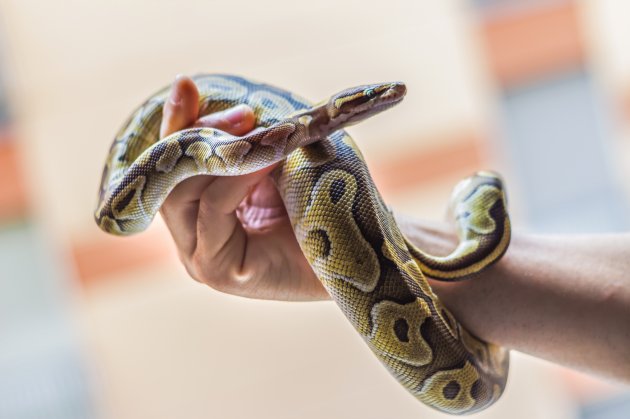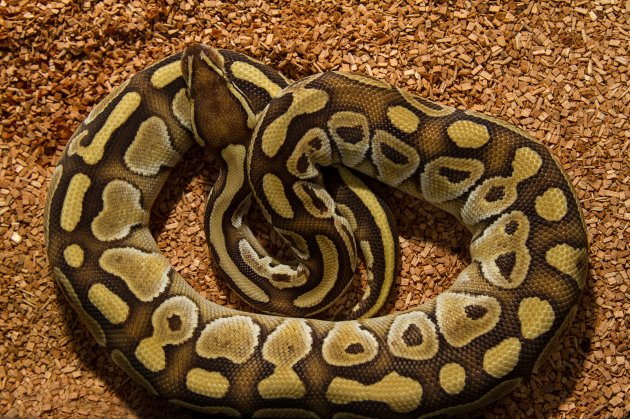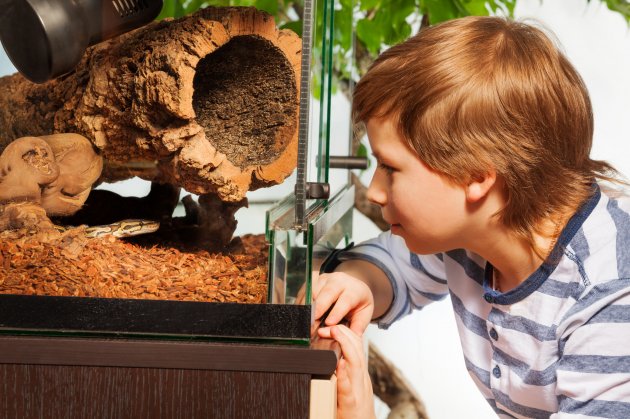Loved and feared by many people alike, Ball Pythons have their fair share of admirers. Among snake pet lovers, Ball Pythons are the most popular choice at the moment; for good reasons! The Ball Python is reasonably easy to take care of even for a novice snake pet owner. But, before rushing to your nearest pet store, here at Pet Comments we’ll give you all the info you need to know about this popular snake.
Appearance
The Ball Python, scientific name Python regius, also known as “Royal Python” is a non-venomous constrictor snake. The color and patterns in its skin changes from one specimen to another; especially if the specimen comes from the pet industry. Selective breeding has produced numerous different mutations in the Ball Python.
Typically, a Ball Python would be of different shades of brown, going from dark brown to very light brown with black and yellow. The pet industry has produced other Ball Python colors like albino (that are completely white and yellow), pastel, lesser, and so on. The Ball Python body is thick and sturdy with a small flat head.
One of the characteristics that makes the Ball Python a popular pet choice among reptile enthusiast is that it is the smallest of its kind. Female Ball Pythons grow till they reach 4 ft. in length, but other specimens have reached the awesome mark of 6 ft. Male Ball Pythons grow till they reach 3.0-3.5 ft. The male body is more slender and the head is smaller than that of the female of the species; still, physical features alone are not enough to differentiate the gender.

Life expectancy
Ball Pythons are long-lived creatures. They live a good 10 years in the wild. Like other animals, the Ball Python can become the prey of bigger predators like bigger snakes, carnivorous mammals, big birds and so on. In captivity, with good care and attention, Ball Pythons can live from 20 to 30 years, the record being 47 years.
Behavior
The Ball Python rarely bites and is generally well-mannered. If it feels threatened, instead of biting, it will tangle itself into a ball, hiding its head beneath its body. This particular behavior is what gave the Ball Python its name. It’s crepuscular, meaning the snake is active the most at dawn and dusk.

Health issues
• Respiratory infections
Like many other animals and even people, snakes can catch a “cold” from time to time. However, unlike humans “just a cold” can prove to be fatal for snakes. The reason is that snakes cannot cough whatever is affecting them out of their system, so is very easy for them to accumulate fluid in their respiratory tracks. A Ball Python with a respiratory infection will have labored breathing, make unusual breathing sounds.
• Snake mites
Dogs and cats lovers both fear and expect to find ticks or fleas on their pets, reptile lovers, on the other side, worry about the infamous reptile mites. Ophionyssus natricis, also called Reptile mites are more commonly found in snakes. These tiny parasites feed on the snake’s blood provoking physical distress in the snake. Sadly, these parasites are common and difficult to eradicate. If you see small “dots” moving in your snake, between the scales, swollen eyes due to the mites beneath the scales, or the snake constantly soaks itself in water, it is probably infested with mites.
• Obesity
Yes, snakes can be fat too! Ball Pythons are constrictor snakes; therefore, they are naturally sturdy and thick. Happily, obesity is a completely avoidable issue if the Ball Python is fed a proper diet.
• Skin issues
Ball Pythons shed every 5 to 7 weeks, during this time this guy may be kind of moody and it is best to leave it to its own self. Humidity is the key to helping the shedding process; still, a damp setting is not recommendable for a snake at all. Too much humidity can lead to skin infections and too little make defecating and shedding impossible for the snake.

Ball Python’s Facts
• Escape artist!
Ball Pythons (and snakes in general) are extraordinarily good at squeezing their way out of their cage or into a tiny space. This is why snake owners must keep a tight watch on cage security.
• Terrible eyesight
Ball Pythons don’t rely on their eyesight to hunt or protect themselves from predators; they detect any possible prey by their heat. So, as beautifully striking as their eyes are, they probably have a blurry sight of you.
• They are non-venomous snakes
Constrictor snakes aren’t venomous; they kill their prey by literally “squeezing” the life out of it. Ball Pythons raised in captivity rarely bite their owners but even if they do is not a mortal bite, just cleaning and disinfecting the wound is enough.
• They love dark corners!
In the wild, Ball Pythons hide in dark caves or under rocks. To make their Ball Python feel more at “home” plenty of snake owners design a dark, hiding space in the snake cage perfect for the snake to laze around there.
• Name origin
The name Ball Python comes from the defensive act of rolling itself into a “ball”, is not the only name it receives tough. The Python regius is also known as the Royal Python; apparently, this flashy snake was used as jewelry for the royalty, hence the name.
• Sexual maturity
Ball Pythons reach sexual maturity when they are five years old and female Ball Pythons breed every two or three years.
• Most popular snake pet!
Ball Pythons are currently the most popular snake pet, regardless of being slightly demanding for a novice owner, Ball Python’s tame and calm nature attracts reptile pet lovers.
• Remember to have water at hand
In the wild is not difficult to find a Ball Python near a source of water, as they love to refresh themselves in the water. In captivity, there should be a bowl of water deep enough for them to immerse in, but not so deep to make getting out difficult for them. This water needs to be changed regularly because the snake often defecates in the water.
• Sacred and respected
Ball Pythons are considered sacred in the Igbo tribe of Nigeria, the story tells that as long time ago this snake helped the people of the Igbo tribe. As a result, whenever a Ball Python enters the village no one bothers it or carefully return it to the woods. If a Ball Python is killed in an incident, they will make a simple funeral for the animal.
Do they make good pets?
Absolutely! One of the things that make the Ball Python so popular among pet lovers is how calm and well-behaved their demeanor is towards their human owners. Of course, these are not dogs you can pet all the time and young Ball Pythons (called hatchlings) will bite out of fear. Once the snake is used to being handled carefully, it is more disposed to just affectionately curl in your arm.
Additional to them being one of the most tolerant snakes (if not the most tolerant one), they are relatively low maintenance. For example, you don’t have to feed your Ball Python three times a day.
First-time snake owners must be warned that all the needs and attention the Ball Python requires are far from the ones a typical pet like a dog or a cat would need. Therefore, before jumping to the next reptile expo, investigate all the necessities of having a Ball Python. If it suits your way of living, go for it!
References and further readings:
- Colette Sutherland, 2006, Ball Pythons (Complete Herp Care)(buy book)
- Lolly Brown, 2017, Ball Pythons as Pets: Caring For Your Ball Python (buy book)
- AnimalPlanet, Ball Python
- ReptilesMagazine, Ball Python Care Sheet